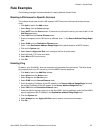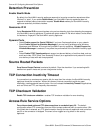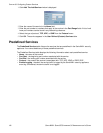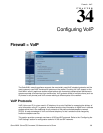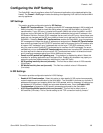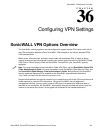194
SONICWALL SONICOS STANDARD 3.0 ADMINISTRATOR’S GUIDE
C
HAPTER
34:
Configuring VoIP
H.323
H.323 is a comprehensive suite of protocols for voice, video, and data communications between
computers, terminals, network devices, and network services. H.323 is designed to enable users to
make point-to-point multimedia phone calls over connectionless packet-switching networks such as
private IP networks and the Internet.
H.323 is widely supported by manufacturers of video conferencing equipment, VoIP equipment and
Internet telephony software and devices.
An H.323 network consists of four different types of entities:
• Terminals - Client end points for multimedia communications. An example would be an H.323
enabled Internet phone or PC
• Gateways - Connectivity between H.323 networks and other communications services, such as
the circuit-switched Packet Switched Telephone Network (PSTN)
• Gatekeepers - Services for call setup and tear down, and registering H.323 terminals for commu-
nications
• Multipoint control units (MCUs) - Three-way and higher multipoint communications between ter-
minals
SIP
Session Initiation Protocol (SIP) is a signaling protocol used in VoIP. Using SIP, a VoIP client can
initiate and terminate call sessions, invite members into a conferencing session, and perform other
telephony tasks. SIP also enables Private Branch Exchanges (PBXs), VoIP gateways, and other
communications devices to communicate in standardized collaboration. SIP was also designed to
avoid the heavy overhead of H.323.




